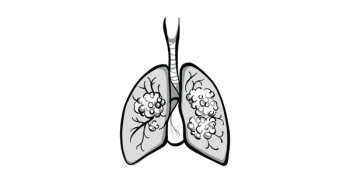
Larotrectinib Shows Activity in Lung Cancer Harboring NTRK Gene Fusions
Larotrectinib was observed to be highly active and have a favorable safety profile in patients with advanced lung cancer whose tumors harbor an NTRK gene fusion, including those with central nervous system metastases.
Larotrectinib (Vitraki) was observed to be highly active and have a favorable safety profile in patients with advanced lung cancer whose tumors harbor an NTRK gene fusion, including those with central nervous system (CNS) metastases, according to updated data presented during the International Association for the Study of Lung Cancer’s 2020 World Conference on Lung Cancer Singapore.1
Larotrectinib, a first-in-class, highly selective, and CNS-active TRK inhibitor, was approved by the FDA for patients with solid tumors and NTRK gene fusions in 2018.2
These data were collected from 14 patients enrolled in a phase 1 (n = 1) and phase 2 (n = 13) clinical trial (NCT02122913 and NCT02576431, respectively) of larotrectinib receiving 100 mg twice daily in continuous 28-day cycles. Thirteen had non–small cell lung cancer and 1 patient had small cell lung cancer. Half of the patients had CNS metastases at baseline. There were 11 (79%) patients with NTRK1 fusions and 3 (21%) patients had tumors with NTRK2 fusions.
“Larotrectinib demonstrated a high response rate with long durability and extended survival benefit in patients with TRK fusion lung cancer, including patients with CNS metastases,” Daniel S. W. Tan, MBBS, MRCP, BSc, FAMS, said in his presentation. “These results support inclusion of NTRK gene fusions in the routine molecular testing of patients with lung cancer.”
In 13 evaluable patients, the objective response rate (ORR) by independent review committee (IRC) was 77% (95% CI, 46%-95%), including 2 complete responses (CRs), 8 partial responses (PRs), and 3 patients with stable disease (SD). By investigator assessment of all the patients (n = 14), the ORR was 71% (95% CI, 42%-92%), with 1 CR, 9 PRs, and 3 patients with stable disease. There were no patients with progressive disease observed in the IRC assessment, but 1 patient had extracranial progression detected in the investigator assessment.
For the patients with CNS metastases at baseline (n = 7), the ORR was 71% (95% CI, 29%-96%), with no CRs, 5 PRs, and 2 patients with stable disease by IRC. In the investigator assessment of this group, the ORR was 57% (95% CI, 18%-90%), with no CRs, 4 PRs, 2 patients with stable disease, and 1 with progressive disease.
The median progression-free survival (PFS), overall survival (OS), and duration of response (DoR) by IRC assessment in all of the patients were not estimable (NE) (PFS range, 7.6-NE; OS range, 17.2-NE; DoR range, 3.6-NE). For patients with CNS metastases, the median PFS, OS, and DoR were 9.9 months, 17.2 months, and 9.5 months, respectively. The estimated PFS rate at 12 months was 61% and the estimated OS rate at 12 months was 91%.
In the overall group of patients, the median time to response was 1.8 months (range, 1.7-7.3). The duration of treatment ranged from 2.1 months to 39.6 or more months. Treatment was ongoing in 9 (64%) patients at the time of the data cutoff of July 15, 2019.
Larotrectinib was well tolerated, according to the investigators. Treatment-emergent adverse events (AEs) were mostly grade 1/2, with the most common being myalgia, cough, and dizziness. Six patients experienced grade 3 AEs and 2 had grade 3 treatment-related AEs. No grade 4/5 toxicities were observed in these patients. No patients permanently discontinued treatment due to AEs.
The median age in this group was 52 years (range 25-76). These patients were heavily pretreated with a median of 3 prior therapies (range 0-5). Male patients made up 57% of the study population.
The primary end point was best ORR per IRC and investigator review. Secondary end points included duration of response, PFS, overall survival, and safety.
Reference:
1. Tan D, Farago A, Kummar S. et al. Efficacy and safety of larotrectinib in patients with tropomyosin receptor kinase (TRK) fusion lung cancer. Presented at: International Association for the Study of Lung Cancer 2020 World Conference on Lung Cancer; January 28-31, 2021; virtual. Abstract MA11.09. Accessed February 2, 2021. https://bit.ly/2LgNM7Y
2. FDA approves larotrectinib for solid tumors with NTRK gene fusions. FDA. Updated December 14, 2018. Accessed January 31, 2021. https://bit.ly/3ovJPJX







































